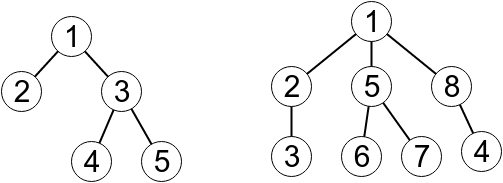Codeforces 639B——Bear and Forgotten Tree 3——————【构造、树】
2016-05-31 21:46
411 查看
Bear and Forgotten Tree 3
time limit per test
2 seconds
memory limit per test
256 megabytes
input
standard input
output
standard output
A tree is a connected undirected graph consisting of n vertices and n - 1 edges. Vertices are numbered 1 through n.
Limak is a little polar bear and Radewoosh is his evil enemy. Limak once had a tree but Radewoosh stolen it. Bear is very sad now because he doesn't remember much about the tree — he can tell you only three values n, d and h:
The tree had exactly n vertices.
The tree had diameter d. In other words, d was the biggest distance between two vertices.
Limak also remembers that he once rooted the tree in vertex 1 and after that its height was h. In other words, h was the biggest distance between vertex 1 and some other vertex.
The distance between two vertices of the tree is the number of edges on the simple path between them.
Help Limak to restore his tree. Check whether there exists a tree satisfying the given conditions. Find any such tree and print its edges in any order. It's also possible that Limak made a mistake and there is no suitable tree – in this case print "-1".
Input
The first line contains three integers n, d and h (2 ≤ n ≤ 100 000, 1 ≤ h ≤ d ≤ n - 1) — the number of vertices, diameter, and height after rooting in vertex 1, respectively.
Output
If there is no tree matching what Limak remembers, print the only line with "-1" (without the quotes).
Otherwise, describe any tree matching Limak's description. Print n - 1 lines, each with two space-separated integers – indices of vertices connected by an edge. If there are many valid trees, print any of them. You can print edges in any order.
Examples
input
output
input
output
input
output
Note
Below you can see trees printed to the output in the first sample and the third sample.

题目大意:给你n、d、h。表示以1结点为根的树,树直径为d,h为树深。问你是否存在这样的树,如果存在输出树的形态,否则输出-1.
解题思路:构造,都是细节。。。
time limit per test
2 seconds
memory limit per test
256 megabytes
input
standard input
output
standard output
A tree is a connected undirected graph consisting of n vertices and n - 1 edges. Vertices are numbered 1 through n.
Limak is a little polar bear and Radewoosh is his evil enemy. Limak once had a tree but Radewoosh stolen it. Bear is very sad now because he doesn't remember much about the tree — he can tell you only three values n, d and h:
The tree had exactly n vertices.
The tree had diameter d. In other words, d was the biggest distance between two vertices.
Limak also remembers that he once rooted the tree in vertex 1 and after that its height was h. In other words, h was the biggest distance between vertex 1 and some other vertex.
The distance between two vertices of the tree is the number of edges on the simple path between them.
Help Limak to restore his tree. Check whether there exists a tree satisfying the given conditions. Find any such tree and print its edges in any order. It's also possible that Limak made a mistake and there is no suitable tree – in this case print "-1".
Input
The first line contains three integers n, d and h (2 ≤ n ≤ 100 000, 1 ≤ h ≤ d ≤ n - 1) — the number of vertices, diameter, and height after rooting in vertex 1, respectively.
Output
If there is no tree matching what Limak remembers, print the only line with "-1" (without the quotes).
Otherwise, describe any tree matching Limak's description. Print n - 1 lines, each with two space-separated integers – indices of vertices connected by an edge. If there are many valid trees, print any of them. You can print edges in any order.
Examples
input
5 3 2
output
1 2 1 3 3 4 3 5
input
8 5 2
output
-1
input
8 4 2
output
4 8 5 7 2 3 8 1 2 1 5 6 1 5
Note
Below you can see trees printed to the output in the first sample and the third sample.

题目大意:给你n、d、h。表示以1结点为根的树,树直径为d,h为树深。问你是否存在这样的树,如果存在输出树的形态,否则输出-1.
解题思路:构造,都是细节。。。
#include<stdio.h>
#include<algorithm>
#include<string.h>
#include<math.h>
#include<string>
#include<iostream>
#include<queue>
#include<stack>
#include<map>
#include<vector>
#include<set>
using namespace std;
typedef long long LL;
#define mid (L+R)/2
#define lson rt*2,L,mid
#define rson rt*2+1,mid+1,R
#pragma comment(linker, "/STACK:102400000,102400000")
const int maxn = 1e4 + 300;
const int INF = 0x3f3f3f3f;
typedef long long LL;
typedef unsigned long long ULL;
int main(){
int n, d, h;
while(scanf("%d%d%d",&n,&d,&h)!=EOF){
if(n == 2){
puts("1 2"); continue;
}
if(d > 2*h){
puts("-1"); continue;
}
if(d == 1 && n > 2){ // 3 1 1 4 1 1
puts("-1"); continue;
}
int st = 2;
if(d == h){
for(int i = 1; i <= d; i++){
printf("%d %d\n",st-1,st); st++;
}
int tst = st;
for(int i = 1; i <= n-tst+1; i++){
printf("%d %d\n",2, st); st++;
}
}else{
for(int i = 1; i <= h; i++){
printf("%d %d\n",st-1,st); st++;
}
for(int i = 1; i <= d-h; i++){
if(i == 1){
printf("%d %d\n",1,st++);
}else{
printf("%d %d\n",st-1,st); st++;
}
}
for(int i = 1; i <= n - d - 1; i++){
printf("%d %d\n",1, st); st++;
}
}
}
return 0;
}相关文章推荐
- 用Golang来AC
- Django入门之自定义页面
- golang C相互调用带参数
- 突破限制爬取网页数据 googlesholar为例【转】
- Django管理后台的搭建
- 为什么golang的for循环后的大括号必须跟在for关键字后面
- 【hdu3635】Dragon Balls —— 并查集
- google chrome 开发者工具选项(三)
- golang实现unicode码和中文之间的转换
- 【Django】本地csv数据的页面table展示
- Win7,8的上帝模式文件夹 GodMode.{ED7BA470-8E54-465E-825C-99712043E01C}
- 打工心态废掉了很多人,包括你吗?(你把现在这家公司的业务都弄清楚、弄懂了吗?君子报仇十年不晚!不离不弃!)good
- ubuntu 相关
- 使用google的zxing生成二维码
- iconv-go升级过程中的编译问题
- Go语言开发环境搭建
- 如何解决atom无法安装package的问题(gyp WARN install got an error, rolling back install)
- Logos语法解析
- ubuntu Go安装与sublime环境搭建
- google浏览器设置自动在新的标签页打开所点击结果
